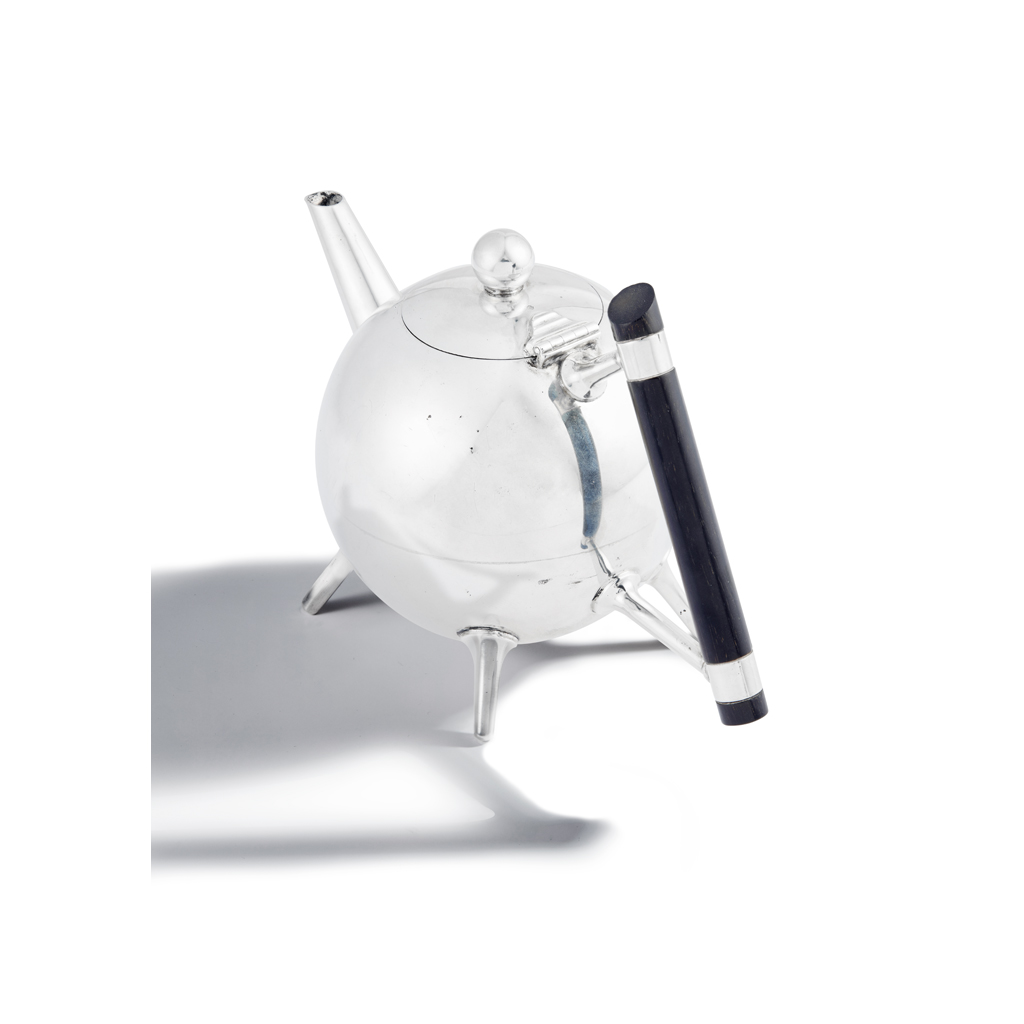CHRISTOPHER DRESSER (1834-1904) FOR JAMES DIXON & SON
SILVER TEAPOT, 1882
£15,000
Decorative Arts: Design since 1860
Auction: 25 October 2017 at 11:00 BST
Description
of sphere form, with ebony handle, stamped maker's marks and facsimile signature J.D.&S./ CHR. DRESSER, hallmarked Sheffield 1882, with Victorian lozenge marks for 25 April 1880, stamped serial numbers 2278/ N27/ 14-11, bears engraved inscription PRESENTED TO MR. FRANK AND MISS CATHERINE HODGKINSON, BY THE DUKE OF PORTLAND, FOR THE BEST YEARLING FILLY, SHEWN AT WELBECK./ AUGUST 2ND. 1887
Dimensions
14cm high
Footnote
Literature: James Dixon and Sons, Cornish Place, Sheffield, Catalogue, 1885, page 96
'Christopher Dresser: A Pioneer of Modern Design', Widar Halen, Phaidon Press Ltd, London, 1993, plate 205
'Christopher Dresser 1834-1904', Michael Whiteway, Skira Editore S.p.A., Milan, 2001, plate 95
'Christopher Dresser and Japan', ed. Koriyama City Museum of Art Brain Trust, 'Christopher Dresser and Japan' Catalogue Committee, Japan, 2002, plate 135
'Christopher Dresser: A Design Revolution', ed. Michael Whiteway, V & A Publications, London, 2004, plate 194, page 15
Note: This rare teapot is one of a group of remarkable designs that the pioneering Victorian designer Christopher Dresser produced for James Dixon & Sons of Sheffield from 1879 -1883.
Christopher Dresser was born in Glasgow in 1834, the son of a tax collector and in his career he became Britain's first professional, independent, industrial designer. Unlike William Morris, his direct contemporary, Dresser fully embraced new production techniques in colour, pattern, material and ornamentation and worked with innumerable manufacturers to produce objects which were well designed and available to many. According to Dresser an object which perfectly fulfilled its function was beautiful in itself and needed no ornament and nowhere is this more apparent than in his metalwork. His early designs were informed by his study of botany however his work was transformed by his trip to Japan in 1876 as the official representative of the Victoria and Albert Museum, giving it a remarkably contemporary appearance.
A series of costings books, held in the archives at Sheffield, reveal that Dresser produced approximately 80 designs for James Dixon & Sons, not all of which are thought to have gone into production. This was possibly due to comparative expense of manufacture, but also because of the radical nature of his designs. Dresser's interest in and close understanding of the process of manufacture and the use of materials are reflected in these books. They show how much each item produced cost to make in detail, how they were made and, in most cases, which were designed by Dresser, as in this case. The illustration shows the entry in the costings book for this teapot and, as well as laying out costs, also shows who would carry out some of the work. The cost, at £1/3s/10d, makes it an expensive item, however unusually the current example is made in silver rather than plate making it a special request and even more expensive to produce. Hallmarked in Sheffield in 1882, this teapot design first appears in the 1879 costings book.
Several other versions of this teapot were made including a version especially created for Tiffany & Co. with hammered decoration. Looking through the books, the majority of the designs are not illustrated, with the exception of those by Dresser, which usually appear as a thumbnail sketch or photograph. This may be an indication that these more expensive and unusual vessels did not appear in their trade catalogues and were perhaps made to order.
This particular example bears an interesting engraving which describes the occasion of its presentation in 1887, five years after its manufacture. The inscription reveals the teapot's likely original owner was the 6th Duke of Portland, William Cavendish-Bentinck. Amongst his long list of prestigious accolades, the Duke held a passion for thoroughbred horse racing and many of the horses he owned won championship races, including the Ascot Gold Cup and his half-sister was the English aristocrat and society hostess Lady Ottoline Morrell. Frank and Kathryn Hodgkinson resided near the Duke of Portland's estate in Nottinghamshire and were awarded the teapot by the Duke for best yearling filly. Kathryn was, in particular, known for her generosity to the staff she employed. Among them was George Maskery, a coachman to the Hodgkinsons who bred the horse mentioned in the engraving. After marrying Kathryn's maid, the Maskerys were gifted many items by Kathryn for their dedicated service, including this teapot by Christopher Dresser.

